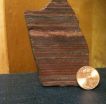(Press-News.org) Astronomers using the National Science Foundation's Green Bank Telescope (GBT) have discovered the most massive neutron star yet found, a discovery with strong and wide-ranging impacts across several fields of physics and astrophysics.
"This neutron star is twice as massive as our Sun. This is surprising, and that much mass means that several theoretical models for the internal composition of neutron stars now are ruled out," said Paul Demorest, of the National Radio Astronomy Observatory (NRAO). "This mass measurement also has implications for our understanding of all matter at extremely high densities and many details of nuclear physics," he added.
Neutron stars are the superdense "corpses" of massive stars that have exploded as supernovae. With all their mass packed into a sphere the size of a small city, their protons and electrons are crushed together into neutrons. A neutron star can be several times more dense than an atomic nucleus, and a thimbleful of neutron-star material would weigh more than 500 million tons. This tremendous density makes neutron stars an ideal natural "laboratory" for studying the most dense and exotic states of matter known to physics.
The scientists used an effect of Albert Einstein's theory of General Relativity to measure the mass of the neutron star and its orbiting companion, a white dwarf star. The neutron star is a pulsar, emitting lighthouse-like beams of radio waves that sweep through space as it rotates. This pulsar, called PSR J1614-2230, spins 317 times per second, and the companion completes an orbit in just under nine days. The pair, some 3,000 light-years distant, are in an orbit seen almost exactly edge-on from Earth. That orientation was the key to making the mass measurement.
As the orbit carries the white dwarf directly in front of the pulsar, the radio waves from the pulsar that reach Earth must travel very close to the white dwarf. This close passage causes them to be delayed in their arrival by the distortion of spacetime produced by the white dwarf's gravitation. This effect, called the Shapiro Delay, allowed the scientists to precisely measure the masses of both stars.
"We got very lucky with this system. The rapidly-rotating pulsar gives us a signal to follow throughout the orbit, and the orbit is almost perfectly edge-on. In addition, the white dwarf is particularly massive for a star of that type. This unique combination made the Shapiro Delay much stronger and thus easier to measure," said Scott Ransom, also of NRAO.
The astronomers used a newly-built digital instrument called the Green Bank Ultimate Pulsar Processing Instrument (GUPPI), attached to the GBT, to follow the binary stars through one complete orbit earlier this year. Using GUPPI improved the astronomers' ability to time signals from the pulsar severalfold.
The researchers expected the neutron star to have roughly one and a half times the mass of the Sun. Instead, their observations revealed it to be twice as massive as the Sun. That much mass, they say, changes their understanding of a neutron star's composition. Some theoretical models postulated that, in addition to neutrons, such stars also would contain certain other exotic subatomic particles called hyperons or condensates of kaons.
"Our results rule out those ideas," Ransom said.
Demorest and Ransom, along with Tim Pennucci of the University of Virginia, Mallory Roberts of Eureka Scientific, and Jason Hessels of the Netherlands Institute for Radio Astronomy and the University of Amsterdam, reported their results in the October 28 issue of the scientific journal Nature.
Their result has further implications, outlined in a companion paper, scheduled for publication in the Astrophysical Journal Letters. "This measurement tells us that if any quarks are present in a neutron star core, they cannot be 'free,' but rather must be strongly interacting with each other as they do in normal atomic nuclei," said Feryal Ozel of the University of Arizona, lead author of the second paper.
There remain several viable hypotheses for the internal composition of neutron stars, but the new results put limits on those, as well as on the maximum possible density of cold matter.
The scientific impact of the new GBT observations also extends to other fields beyond characterizing matter at extreme densities. A leading explanation for the cause of one type of gamma-ray burst -- the "short-duration" bursts -- is that they are caused by colliding neutron stars. The fact that neutron stars can be as massive as PSR J1614-2230 makes this a viable mechanism for these gamma-ray bursts.
Such neutron-star collisions also are expected to produce gravitational waves that are the targets of a number of observatories operating in the United States and Europe. These waves, the scientists say, will carry additional valuable information about the composition of neutron stars.
"Pulsars in general give us a great opportunity to study exotic physics, and this system is a fantastic laboratory sitting out there, giving us valuable information with wide-ranging implications," Ransom explained. "It is amazing to me that one simple number -- the mass of this neutron star -- can tell us so much about so many different aspects of physics and astronomy," he added.
INFORMATION:
The National Radio Astronomy Observatory is a facility of the National Science Foundation, operated under cooperative agreement by Associated Universities, Inc.
END
RIVERSIDE, Calif. – A team of scientists, led by biogeochemists at the University of California, Riverside, has found new evidence linking "Snowball Earth" glacial events to the rise of early animals.
The controversial Snowball Earth hypothesis posits that the Earth was covered from pole to pole by a thick sheet of ice lasting, on several occasions, for millions of years. These glaciations, the most severe in Earth history, occurred from 750 to 580 million years ago. The researchers argue that the oceans in the aftermath of these events were rich in phosphorus, a nutrient ...
Boston, MA—A new study has found that regular consumption of soda and other sugar-sweetened beverages is associated with a clear and consistently greater risk of metabolic syndrome and type 2 diabetes. According to the Harvard School of Public Health (HSPH) researchers, the study provides empirical evidence that intake of sugary beverages should be limited to reduce risk of these conditions.
The study appears online October 27, 2010, in the journal Diabetes Care and will appear in the November print edition.
"Many previous studies have examined the relationship between ...
Pancreatic cancer develops and spreads much more slowly than scientists have thought, according to new research from Johns Hopkins investigators. The finding indicates that there is a potentially broad window for diagnosis and prevention of the disease.
"For the first time, we have a quantifiable estimate of the development of pancreatic cancer, and when it would be best to intervene," according to Christine Iacobuzio-Donahue, M.D., Ph.D., associate professor of pathology and oncology at Hopkins' Sol Goldman Pancreatic Cancer Research Center, "so there is potentially ...
Researchers at the University of Bristol reveal today in the journal Nature that they have developed a seismological 'speed gun' for the inside of the Earth. Using this technique they will be able to measure the way the Earth's deep interior slowly moves around. This mantle motion is what controls the location of our continents and oceans, and where the tectonic plates collide to shake the surface we live on.
For 2,900 km (1800 miles) beneath our feet, the Earth is made of the rocky mantle. Although solid, it is so hot that it can flow like putty over millions of years. ...
Green tea does not protect against breast cancer. A study of data from approximately 54,000 women, published in BioMed Central's open access journal Breast Cancer Research, found no association between drinking green tea and breast cancer risk.
Motoki Iwasaki, from the National Cancer Center, Tokyo, worked with a team of researchers to carry out the study. He said, "Although in vitro and animal-based studies have suggested that green tea may have beneficial protective effects against breast cancer, results from human studies have been inconclusive. Our large-scale, population-based ...
In new research published today, researchers uncover evolution in action in cancer cells. They show the forces of evolution in pancreatic tumours mean that not only is cancer genetically different between different patients, but each new focus of cancer spread within a patient has acquired distinct mutations.
Effectively, ten different foci of cancer spread are ten different, but related, tumours. The complexity of pancreatic cancer genetics uncovered in this work helps to explain the difficulty of treating the disease but also strengthens the need for improved methods ...
(SALT LAKE CITY)—Just seven months after University of Utah geneticists took part in a landmark study that sequenced for the first time the genome of an entire Utah family, U of U researchers have taken part in another historic study that is the first large-scale genome sequencing project – 179 people representing three continents – and 60 Utahns played a major role in this study, too.
Published Wednesday, Oct. 27, 2010, in Nature, the study demonstrates how quickly the science of genome sequencing is expanding – first from individuals, then to families, and now to large ...
BOSTON--A new oral drug caused dramatic shrinkage of a patient's rare, aggressive form of soft-tissue cancer that was driven by an abnormally activated protein, physician-scientists from Dana-Farber Cancer Institute report in the Oct. 28 issue of the New England Journal of Medicine.
A second patient who had a similar tumor that was not fueled by the mutant protein, called ALK (named for the first disease in which it was found, anaplastic lymphoma kinase), failed to respond to the drug, said the researchers, confirming the inhibitor's specificity for the abnormal protein. ...
Scientists have invented methods to scout the human genome's repetitive landscapes, where DNA sequences are highly identical and heavily duplicated. These advances, as reported today in Science, can identify subtle but important differences among people in the number and content of repeated DNA segments.
These copy number variations partly account for the normal diversity among people. Copy number variations might also be why some people, and not others, have certain disorders or disease susceptibilities, and might also determine how severely they are affected.
Until ...
STANFORD, Calif. — The immune system may play a critical role in ensuring the success of certain types of cancer therapies, according to a new study by researchers at the Stanford University School of Medicine. The research showed treatments that disable cancer-promoting genes called oncogenes are much more successful in eradicating tumors in the presence of a signaling molecule secreted by kind of immune cell called a T helper cell.
The finding is important because many drugs now in use in humans are often tested in lab animals with weakened immune systems and many human ...


